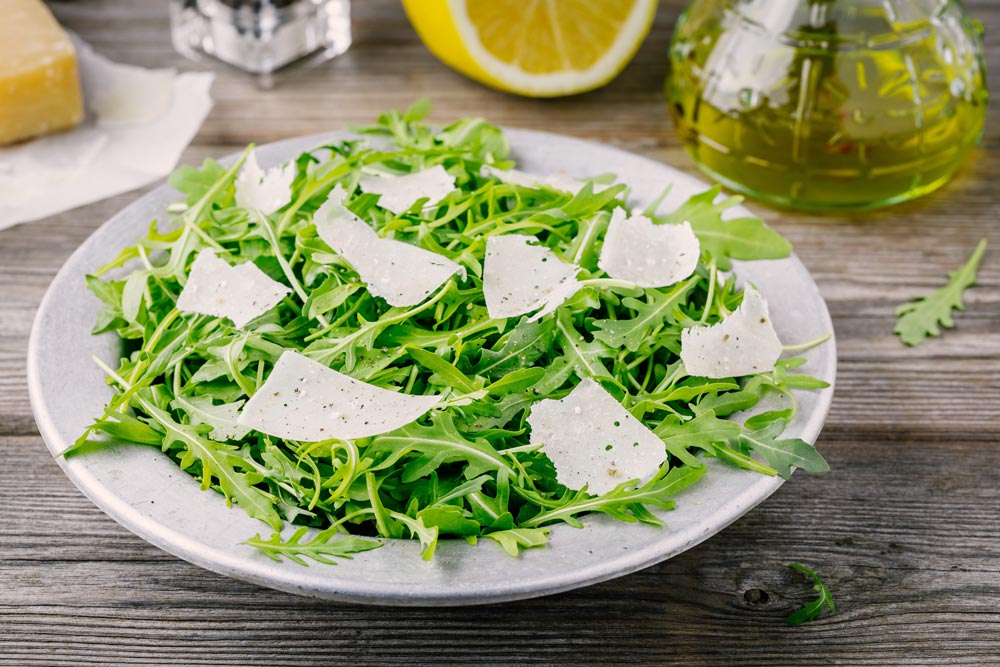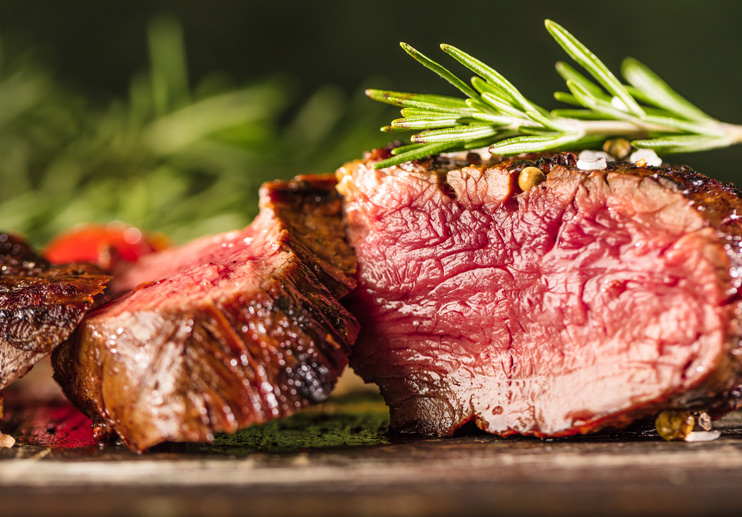Watch T. J. Robinson prepare a no-mess, no-fuss arugula salad with fresh, baby arugula, fresh squeezed lemon, lemon zest and fresh-pressed olive oil. This is a super simple, super fast salad, perfect for a weeknight.
Garlic- and Pepper-Crusted Beef Tenderloin
Ancient Indian and Egyptian cultures used peppercorns as an anti-inflammatory and analgesic. Rich in antimicrobial compounds, pepper acted as a preservative, too. Contemporary research has found that there’s science to back up those early practices, thanks primarily to the powerful compound piperine, the source of its spicy punch. It has enzymes that help the body better absorb both conventional and herbal medications—turmeric supplements often come with piperine for this reason. There’s even the possibility that it could play a role in the development of medications to combat illnesses as varied as Parkinson’s, cancer, and depression. According to studies in Phytotherapy Research and other journals, although research is still in the early stages (most has been done only in the lab), one day there could be value well beyond pepper’s great taste for making it an important part of the diet.
Ingredients
- 8 cloves garlic, peeled
- 2 tablespoons kosher salt
- 1/3 cup extra virgin olive oil plus 2 tablespoons for searing
- 1 tablespoon freshly cracked black peppercorns
- 2 tablespoons fresh thyme leaves
- 1/4 cup fresh rosemary needles from a 3- or 4-inch sprig
- 2 tablespoons coarse grain mustard
- One 3-pound center-cut beef tenderloin, trimmed
Directions
Step 1
Preheat your oven to 450ºF. In a small food processor, combine the garlic and salt and process until the garlic is finely chopped. Let it rest for 10 minutes for the powerful allicin in the garlic to develop. Add the olive oil, black pepper, thyme, and rosemary, and process until the herbs are evenly chopped. Stir in the mustard.
Step 2
Heat a large cast iron skillet or Dutch oven on the stovetop. Add the remaining 2 tablespoons of olive oil and heat until it shimmers. Sear the beef tenderloin on all sides until nicely browned, 3 to 4 minutes per side, turning with tongs. Transfer the meat to a cutting board and let cool slightly.
Step 3
Coat the meat evenly on all sides with the garlic, pepper, and herb mixture. Transfer the tenderloin to a meat rack set in a roasting pan. Roast the tenderloin until the internal temperature reaches desired doneness on an instant-read thermometer, about 20 to 30 minutes (depending on its thickness). So that the juices will redistribute, let it rest for at least 10 minutes before carving.
| Yields 8 servings. |
Composed Pear Salad With Port Vinaigrette
This dish is made for the fall, when pears are bountiful across the US. It’s also an effortless way to put together a composed salad for a brunch, a lunch or even a meatless supper with a combination of ingredients that is a little surprising…and totally delicious. While you can use poached pears or even grill pear halves just as you would bell peppers, for an elegant meal in minutes, pick a pear variety that tastes best au naturel (see the Healthy Ingredient Spotlight below to get familiar with varieties besides Bartlett). The vinaigrette is great on everything, so if you have extra, enjoy it on steamed veggies or even as a marinade for chicken breasts.
Ingredients
- 1/4 cup good-quality red wine vinegar
- 2 tablespoons port wine
- 1 tablespoon honey, preferably eucalyptus honey
- 1/2 teaspoon salt or more to taste
- 1/2 teaspoon coarsely ground black pepper
- 3/4 cup extra virgin olive oil
- 6 cups salad greens, such as mesclun or a mix of frisée, arugula and mâche, torn if needed
- 2 ripe, unpeeled pears, such as Bartlett, Anjou, Comice or Starkrimson, halved and cored
- 4 tablespoons Gorgonzola Dolce or another creamy and mild blue cheese
- 1/3 cup hazelnuts, toasted and chopped
- 1/3 cup pomegranate seeds
Directions
To make the vinaigrette, add the vinegar, port, honey, salt and pepper to a blender. Turn on the machine and slowly trickle in the olive oil through the cap in the lid, processing until emulsified. Divide the salad greens among four plates. Center a pear half, cut side up, over the greens on each plate, and fill the center of each pear with a spoonful of the cheese. Drizzle a tablespoon of the vinaigrette over the pears and greens, then sprinkle on equal amounts of the nuts and pomegranate seeds.
| Yields 4 servings |
Dried Apricot and Cranberry Pilaf
Rice is the perfect vehicle for a wide range of flavors, both sweet and savory. I’m a fan of the subtle aroma of jasmine rice, but any long grain will work. Dried apricots and cranberries are evocative of the season and give this pilaf a sweet-tart taste, but feel free to use whatever dried fruits you like, instead of or even in addition to. When sprinkled on the finished dish, the fresh orange zest gives it a wonderful perfume. I love to use a Microplane grater because it makes such a fine zest, and it’s so easy to move over the entire surface of the peel to get all the goodness.
Ingredients
- 1 medium onion, diced
- 2 tablespoons extra virgin olive oil
- 1 cup jasmine or basmati rice
- 2-1/4 cups chicken broth, homemade or low-sodium canned
- 1/2 cup dried apricots, chopped fine
- 1/3 cup dried cranberries, chopped fine
- 3 tablespoons sliced almonds, toasted
- 2 tablespoons chopped Italian flat-leaf parsley
- Freshly ground pepper to taste
- 1 tablespoon or more orange zest
- Pinch of cinnamon, optional
Directions
In a covered saucepan over medium-low heat, sauté the onion in the olive oil until translucent. Add the rice, stirring to coat it in the oil. (This helps keep the grains distinct in the finished dish.) Stir in the broth and increase the heat to medium. Bring to a low boil, cover, and cook until the rice is tender and most of the liquid is absorbed, about 20 minutes. Stir in the apricots and cranberries and remove the pan from the heat. Put the cover back on, wait another 5 minutes, and then fluff the rice with a fork. Stir in the almonds, parsley, and freshly ground pepper. Transfer to a serving bowl and grate the orange zest right over the top. Sprinkle with cinnamon if desired.
| Yields 4 servings. |




